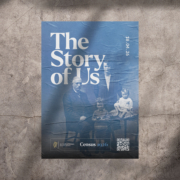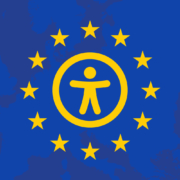
The Story of Us


Imagine getting to a train station in the morning and realising you can’t access the platform. You approach the station and are greeted by an eerie silence — no station personnel, no fellow commuters—just an unsettling quiet. You head towards the lift that is supposed to carry you to the platform. But as you reach its metallic doors, you encounter an unexpected barrier — the lift is out of service. You feel a surge of frustration and isolation wash over you. You had provided advance notice for your journey, yet no one was here to assist you.
This is an example of the barriers that people with disabilities experience daily in Ireland — challenges that we often overlook. We are not nearly good enough at providing accessibility across the board in Ireland — but we are getting better.
One area, though, in which we have seen tremendous changes in Ireland in recent years is digital accessibility. Digital accessibility involves making websites, apps, and other online content so anyone with disabilities can use it easily. There are several reasons for the growth, including legal requirements, inclusivity, business benefits, and advancement in technology.
In other words, it’s good for business.
Businesses are starting to pay more attention to making their digital platforms accessible to everyone. They realise that this is important for inclusivity and because it helps them connect with a larger and more diverse audience. In other words, it’s good for business.

One of the triggers for the push for digital accessibility was the implementation of the EU Accessibility Directive. This regulation aims to make websites and mobile apps of public sector bodies across the EU more accessible for people with disabilities.
The directive came into force in 2020 and requires that these websites meet specific accessibility standards which are the Web Content Accessibility Guidelines (WCAG) 2.1, Level AA. In short, these are a list of rules for making the web available to everyone. The public sector body must also publish an accessibility statement describing their compliance with the directive.
The overall objective is to ensure that people with disabilities have equal access to information and services provided online by public sector bodies. The National Disability Authority (NDA) monitors and reports on the directive in Ireland.
Until now, there has been a lack of legislation aimed at the private sector, and unfortunately, it shows. Looking at the Irish Times’ 2022 list of the top 100 companies in Ireland, 73% failed web accessibility checks.
The European Accessibility Act (EAA) is coming in 2025. It is broadly similar to the act that covers public bodies and aims to harmonise accessibility requirements for certain products and services to benefit businesses, older people, and people with disabilities. It also aims to clarify existing accessibility obligations in EU law. The law is much broader in scope than the previous legislation for public bodies. One of the crucial things that the act covers in its scope is e-commerce; this means all online transactions in the EU are covered under the act.
In the world of digital accessibility, one of the most famous stories revolves around a man named Guillermo Robles and a popular pizza chain. Guillermo, who is blind, wanted to order a pizza from Domino’s using their website and mobile app. However, he found it impossible to do so with his screen-reading software. Frustrated but determined, he took his case to court, arguing that this digital roadblock violated his rights under the Americans with Disabilities Act (ADA). The court ultimately ruled in his favour, setting a powerful precedent that businesses must ensure their digital spaces are open and welcoming to everyone, regardless of their abilities.
With the introduction of the EAA, we may see cases like this come to Europe soon. The EAA goes into effect on June 28, 2025, which is:
We often hear talk of the ‘Carrot and the Stick’ about digital accessibility. In Ireland, the number of people who have a disability or a disabling condition is increasing. In the 2022 Census, 1,109,557 people (22% of the population) reported having a long-lasting condition/difficulty or disability to any extent. These people will use the websites of businesses and organisations with easily accessible platforms. That is the carrot. The EAA is the stick. It is a rather large stick. Fines and penalties are on the high end.
By integrating these practices into regular website maintenance, businesses can ensure their websites remain accessible and inclusive for all users.
We believe that accessible design means better design, which is at the heart of our design process. Whether we’re crafting digital experiences or designing physical spaces like exhibitions or wayfinding systems — our commitment to accessibility remains.
Our team specialises in developing accessible digital experiences that conform to the highest standards, including those set by the European Accessibility Act. We offer a wide range of services, including website design, development, user testing, and continuous support, all customised to suit the specific needs of each client.
We can help your organisation meet your website accessibility goals and make your website more inclusive.
Contact our Accessibility Lead, Declan Behan or Director Diarmuid Slattery to discuss your project.